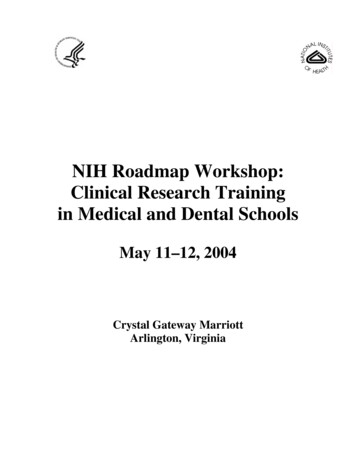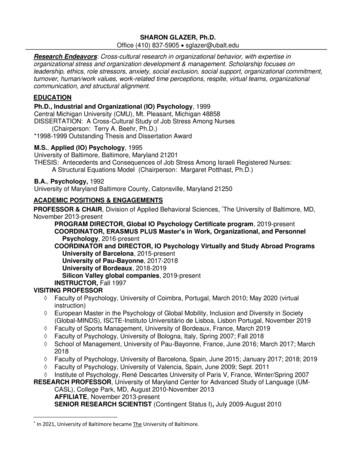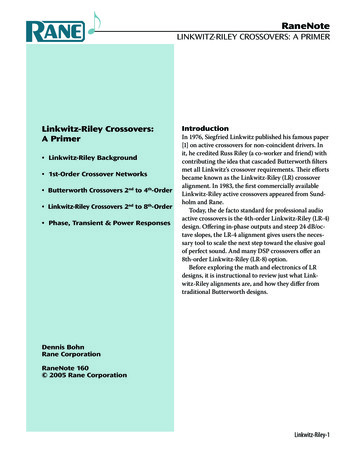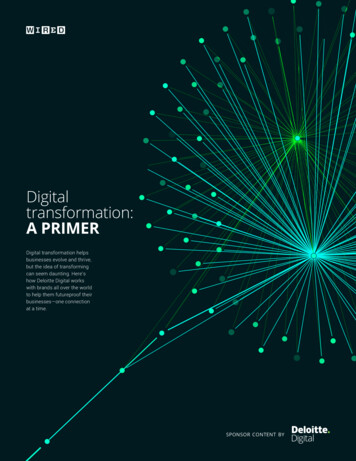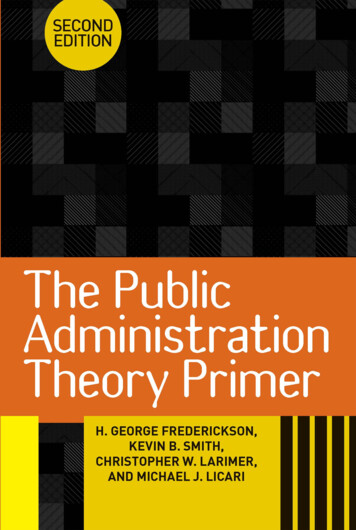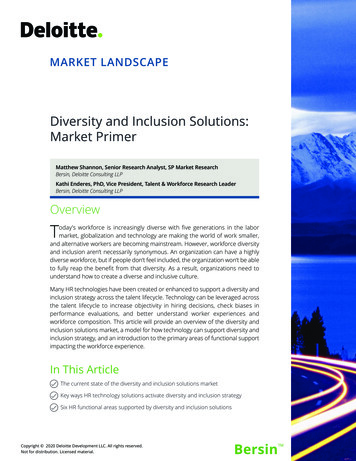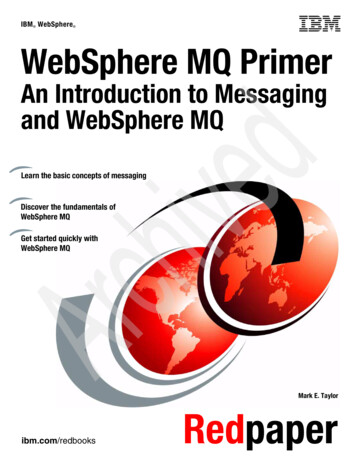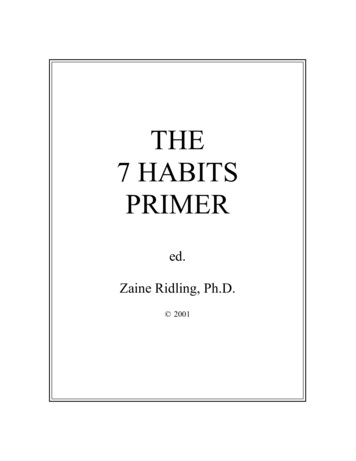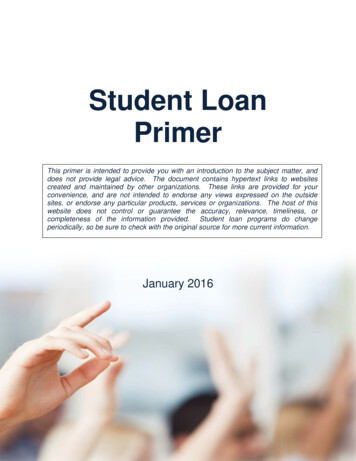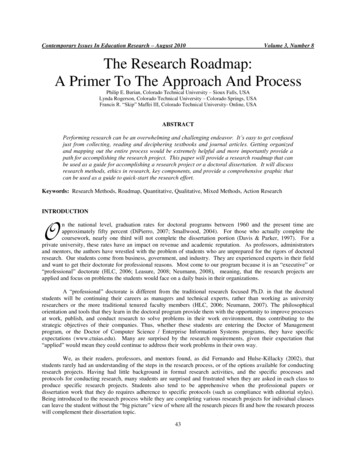
Transcription
Contemporary Issues In Education Research – August 2010Volume 3, Number 8The Research Roadmap:A Primer To The Approach And ProcessPhilip E. Burian, Colorado Technical University – Sioux Falls, USALynda Rogerson, Colorado Technical University – Colorado Springs, USAFrancis R. ―Skip‖ Maffei III, Colorado Technical University- Online, USAABSTRACTPerforming research can be an overwhelming and challenging endeavor. It’s easy to get confusedjust from collecting, reading and deciphering textbooks and journal articles. Getting organizedand mapping out the entire process would be extremely helpful and more importantly provide apath for accomplishing the research project. This paper will provide a research roadmap that canbe used as a guide for accomplishing a research project or a doctoral dissertation. It will discussresearch methods, ethics in research, key components, and provide a comprehensive graphic thatcan be used as a guide to quick-start the research effort.Keywords: Research Methods, Roadmap, Quantitative, Qualitative, Mixed Methods, Action ResearchINTRODUCTIONOn the national level, graduation rates for doctoral programs between 1960 and the present time areapproximately fifty percent (DiPierro, 2007; Smallwood, 2004). For those who actually complete thecoursework, nearly one third will not complete the dissertation portion (Davis & Parker, 1997). For aprivate university, these rates have an impact on revenue and academic reputation. As professors, administratorsand mentors, the authors have wrestled with the problem of students who are unprepared for the rigors of doctoralresearch. Our students come from business, government, and industry. They are experienced experts in their fieldand want to get their doctorate for professional reasons. Most come to our program because it is an ―executive‖ or―professional‖ doctorate (HLC, 2006; Leasure, 2008; Neumann, 2008), meaning, that the research projects areapplied and focus on problems the students would face on a daily basis in their organizations.A ―professional‖ doctorate is different from the traditional research focused Ph.D. in that the doctoralstudents will be continuing their careers as managers and technical experts, rather than working as universityresearchers or the more traditional tenured faculty members (HLC, 2006; Neumann, 2007). The philosophicalorientation and tools that they learn in the doctoral program provide them with the opportunity to improve processesat work, publish, and conduct research to solve problems in their work environment, thus contributing to thestrategic objectives of their companies. Thus, whether these students are entering the Doctor of Managementprogram, or the Doctor of Computer Science / Enterprise Information Systems programs, they have specificexpectations (www.ctuias.edu). Many are surprised by the research requirements, given their expectation that―applied‖ would mean they could continue to address their work problems in their own way.We, as their readers, professors, and mentors found, as did Fernando and Hulse-Killacky (2002), thatstudents rarely had an understanding of the steps in the research process, or of the options available for conductingresearch projects. Having had little background in formal research activities, and the specific processes andprotocols for conducting research, many students are surprised and frustrated when they are asked in each class toproduce specific research projects. Students also tend to be apprehensive when the professional papers ordissertation work that they do requires adherence to specific protocols (such as compliance with editorial styles).Being introduced to the research process while they are completing various research projects for individual classescan leave the student without the ―big picture‖ view of where all the research pieces fit and how the research processwill complement their dissertation topic.43
Contemporary Issues In Education Research – August 2010Volume 3, Number 8CONCEPTUAL FRAMEWORKMentoring and Social SupportA review of the professional literature identifies that mentoring and social support are two of the mosthelpful means of reversing this trend (Di Pierro, 2007; Bell-Ellison& Dedrick, 2008; Hall & Burns, 2009; Harris,2007; Ku, et. al.,2007; Protvenak, 2009; Whitley & Oddi, 1998). Many of these researchers who have exploredmentoring, point to the importance of demonstrating respect for the doctoral student, helping students make thetransition from student to professional researcher (Hall & Burns, 2009), building social support networks (Roberts &Plakhotnik, 2009), providing continuing faculty support and guidance (Di Pierro, 2007; Melies, Hall & Stevens,1994)) in developing effective research skills through team research (Fernando & Husle-Killackey, 2002),providing tools and explanations of research processes (Hollingsworth & Fessinger, 2002), socializing students tothe research process (McElmurry & Minckley, 1986) and collaborating on publishing projects (Conn, 1995; Whitley& Oddi, 1998; Whitley, Oddi & Tyrrell, 1998). Ku and associates (2008) conducted an intensive study on thementoring needs of international students, noting that many have language, socialization and identity challengesbeyond coursework and the honing of research skills. Several articles indicated that many students entering thedoctoral program had little or no experience with the research process and that their understanding of research mightbe quite different from that of their professors and mentors (Fernando & Hulse-Killacky, 2002; Green & Bauer,2009; Hall & Burns, 2009).Research Process and Design ResourcesA variety of textbooks provide overviews of the research process. These resources can provide structureand a depth of understanding for the philosophical orientation of various research approaches, research approacheswithin qualitative and quantitative approaches, and the various methodologies for each approach. Of course, thereare many textbooks on research available, with many that are specific to a discipline. Those presented here are usedto support the development of research skills among our doctoral student population.Plano-Clark and Creswell (2010) outline a seven step process and demonstrate how this process frames theconstruction of reports of research studies. The seven steps (adapted from p. 67) include the following: (1) describethe research problem; (2) review of the literature; (3) Identifying the purpose of the research; (4) Choosing researchdesign and data collection method; (5) Analysis of data and reporting the results; (6) Interpreting and discussing thedata; and (7) evaluating the research process and publishing. This approach is very helpful in that it helps thestudent learn how various types of research studies (quantitative, qualitative, mixed methods, and action research)are structured, approached, and written. In learning this process, students can also learn how published researchreports are analyzed and critiqued. As an entry level text, this information can provide the confidence that studentsneed and also help them to see the relevance of various statistical procedures, the role of qualitative and quantitativeresearch designs, and when to use each type.John Creswell (2009) provides valuable instruction on research design. In his text on research design, headdresses qualitative, quantitative and mixed methods approaches. He frames each research approach from itsphilosophical roots and its purpose in the overall research approach. In an earlier text, Creswell (2007) addressesfive different traditions for qualitative research. Creswell and Plano Clark (2007) offer an overview of mixedmethods approaches for research designs including quantitative and qualitative approaches. This text provides ahelpful comparison of quantitative, qualitative and mixed methods designs.Maxwell (2004) provides a way of thinking about qualitative research, including how to develop reflectivethinking. Wolcott (2001) provides an approach for students to find their own voice in writing up qualitative researchstudies. Schön (1995) zeros in on the process of reflective thinking that enables students to position themselves asreflective practitioners, providing an understanding of how to experience and explore the problems that they see inthe workplace and to apply new approaches for problem solving.Pryczak Publishing is an excellent resource for ―how to‖ manuals for quantitative and qualitative researchapproaches. These manuals provide detailed (and easy to read) instructions for how to conduct various statistical44
Contemporary Issues In Education Research – August 2010Volume 3, Number 8procedures (Pyrczak, 2010), advanced multivariate statistical methods (Mertler & Vannatta, 2010), how to reviewresearch articles (Pyrczak, 2008), how to write literature reviews (Pan, 2008), how to use sources properly (Harris,2005) and many other topics that can assist students in enhancing their understanding of the various elements of theresearch process. Of course there are many other textbooks available on these topics as well. This series, availableat www.pyrczakpublishing.com, provides an economical way to focus on the specific areas that need to bedeveloped.Understanding the philosophical and theoretical paradigms that frame the research approaches is veryimportant for helping doctoral students to understand the ―schools of thought‖ or points of view for research studies.These paradigms provide the foundation of assumptions and beliefs that researchers use to direct their studies. Asstudents learn more about these philosophical approaches and how they are used to guide research studies, theybecome more aware of their own points of view and philosophical orientations. Prasad (2009) provides aphilosophical orientation to the various qualitative approaches to research, setting them within the intellectualframework of post modern philosophy. Creswell (2006) provides an orientation to the five traditions of qualitativeinquiry, setting each within its philosophical framework. Hatch (2004) provides a view of positivist and postmodern perspectives of organization theory that serves to situate the student in relation to the various theoreticalperspectives for management and organizational projects. Oates (2007) explores various applications forquantitative and qualitative research for computer science. Two chapters in the book are devoted to exploringphilosophical assumptions. Oates also provides excellent examples of published research reports in the referencesfor each chapter.There are also individual books that support the learning process around specific methodologies andresearch designs such as case studies (Yin, 2008), designing survey questions (Fowler, 1995; Rea & Parker 2005),qualitative data analysis (Auerbach & Silverstein, 2003; Bazeley, 2007, Boyatzis, 1998; Miles & Huberman, 1994),conducting interviews (Rubin & Rubin, 2004; Seidman, 2006), and approaches to ethnography (Emerson, 1995).For each research design or data collection methodology and analysis, there are books that provide instruction andfocus for students who are struggling to understand. Supplementing course survey textbooks with titles that focuson specific tasks can help the student to develop confidence and skill. Mentors and course instructors couldintroduce these resources as the students begin to develop their own research projects.For many applied doctoral students, making improvements in their communities or organizations is animportant goal. The action research model provides an option that allows teamwork, continuous improvement,empowerment, and problem solving at the practice level. A variety of textbooks can be used to develop theunderstanding and skills for conducting action research in the community or the organization ( Coghlan & Brannick,2009; Greenwood & Levin, 2006; McIntyre, 2007; Reason & Bradbury, 2001; Stringer, 2007) and for developingaction research dissertations (Herr & Anderson, 2005). While this approach to research has not been widelyaccepted in all doctoral programs, some of the more current books, (listed above) emphasize the research protocoland help the student deliver a professional research report that can also meet the requirements of doctoral research.This option provides students in management and in computer sciences with a more flexible approach to theirdissertation process.THE RESEARCH ROADMAPThe framework of the Research Road Map (Appendix A) addresses both the research process and a numberof research options, in a matrix format with columns representing the steps in the research process and rowsrepresenting elements in the research designs. This model allows novice researchers to locate where they are in theprocess and compare research designs, options for methods, analysis and interpretation.The expectation is that having this tool as a roadmap to research will alleviate some of the confusion andhelp students to make better research project choices. If provided at the beginning of the program, the student canuse the Research Road Map to track what they are learning in each of the courses, thereby linking together theconcepts, processes and philosophical orientations of the various research elements. This should also assist them inapproaching their dissertation project or their professional articles with more confidence.45
Contemporary Issues In Education Research – August 2010Volume 3, Number 8The ProcessThe first step of the Research Roadmap is to lay out the process for the research project. The processincludes nine tasks: Topic selection; Purpose Statement; Research Question; Literature Search; ResearchMethodology/Design: Data Collection Tools; Research Proposal; Collection & Analysis: and Reporting. It is alsoimportant to note that while the sequence ―looks‖ linear in the model, in actual practice there is a great deal ofiterative or recursive effort, circling back, to refine and revise earlier steps. It is also important to note, thatdepending upon the research design, some of the linear steps are actually done simultaneously (i.e. data collectionand analysis). As the student gains more confidence in each of the process steps, it will become necessary to makeadjustment to earlier steps. Helping students to recognize the sequence of the various research activities that arerequired and their role in the research process (i.e. defining a topic, choosing the research question, completing theannotated bibliography and the literature review) can make doing research based projects more meaningful andbeneficial. Plano Clark and Creswell (2009) address the process of both qualitative and quantitative research byhaving the student identify the elements of the process in published articles. Thus, the students are able to see howthe process looks in published form. It is also helpful to have students examine completed dissertations. Proquestonline database (n. d.; 2009) provides a search option to find dissertations on a variety of topics that can demonstratewhat is expected in the final project. And, the student can use the completed dissertation and a research article toidentify the specific elements of the research process. This will give them a much better understanding of how theprocess steps show the progression of the research project.The Research OptionsThroughout the doctoral program (and even within many master’s degree programs) conducting smallresearch projects is part of the pedagogical design. It has been our collective experience that students enter intothese projects blindly, and try to complete the project by rote, not understanding the reasons behind research designsand methodologies. By linking the aspects of the various research designs to the stage of the research process,students can see where they are going, and what options are available to them. The resource texts can provide thenecessary ―how to” for each choice. The Research Road Map identifies four research options: quantitative,qualitative, mixed methods and action research.RESEARCH METHODS AND DESIGNSQuantitative ResearchQuantitative research methodology is a powerful form of inquiry. For most students, this is the type ofresearch they have come to expect and what they understand as ―research.‖ Students will recognize the processfrom their high school science fair days: (1) Ask the question; (2) Conduct the background search; (3) Construct ahypothesis; (4) Create an experiment to test the hypothesis; (5) Analyze the results of the data and draw conclusions;(6) Disseminate results in a report. Philosophically, this form of research comes from the Positivist perspective(Creswell, 2007; Hatch, 1997; Oates, 2004; Prasad, 2005). Researchers from this intellectual camp look foruniversal laws and govern cause and effect. They look for the ―one‖ theory that explains everything. Their focus ison what they can see and observe and they test their ideas or assumptions by manipulating the variables of theirstudy. Plano Clark and Creswell (2009) outline five different categories of quantitative research designs:experimental, quasi-experimental, single subject experiments, correlation, and survey research designs. Each one ofthese is designed to solve a different type of research problem. It is important that students understand the purposeand focus of each one. It is also helpful for students to explore published research reports that address each one ofthese designs. Doing so will also make them aware of the value and benefits of learning the various statisticalanalysis procedures; and they approach those classes with an eagerness that is missing when this step is ignored.An example of a quantitative research project would be developing an electronic component based on twodifferent kinds of software. The research question might be which software enables the electronic component toperform faster and more efficiently. The hypothesis is that software A will outperform software B using a specificset of criteria. The research design would be to conduct an experiment and based on a specific set of criteria theperformance is measured to determine the best performing and most efficient software for the electronic component.46
Contemporary Issues In Education Research – August 2010Volume 3, Number 8The focus on hypothesis testing is really what distinguishes quantitative versus qualitative research (Creswell,2006).Qualitative ResearchThe qualitative research methodology developed out of the social sciences and can trace its roots toanthropology and sociology. The philosophical paradigm that shapes the assumptions of qualitative approaches isthat of the post modern approach, rather than the positivist approach that characterizes the scientific method and thequantitative research designs. Prasad (2005) and Hatch (1997) address the differences between these two approachesfrom the research perspective and from the organization theory perspective. Helping students to learn thephilosophical foundation for qualitative research helps also to understand the reasoning behind the five differentresearch designs that are commonly used in qualitative research: phenomenology, ethnography, case study,narrative, and grounded theory research. Prasad (2005) also addresses a variety of other research designs inqualitative projects such as dramaturgy, ethno methodology.Researchers who use qualitative research designs for their studies are interested in understanding, inexploring, and discovering. They use interviews, focus groups, analyze documents, observe behaviors in groups,investigate culture, and look for trends and patterns in the data they collect. In the grounded theory approach(Charmanz, 2006), the research actually builds a theory from the data that is collected and can even establish a set ofpropositions or hypotheses that could be tested using quantitative approaches. An example of a phenomenologicalqualitative research s
The expectation is that having this tool as a roadmap to research will alleviate some of the confusion and help students to make better research project choices. If provided at the beginning of the program, the student can use the Research Road Map to track what they are lear
